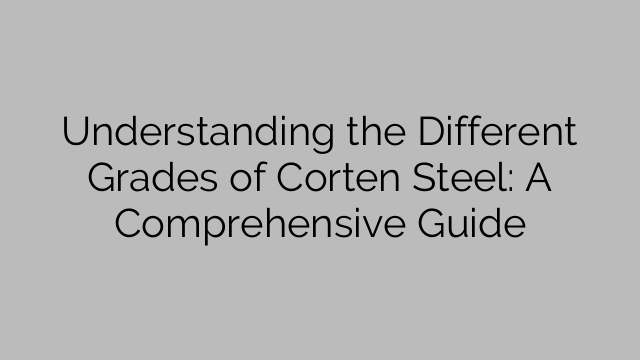Corten steel, also known as weathering steel, has become increasingly popular in the construction industry due to its unique properties and aesthetic appeal. It is a type of steel alloy that forms a protective outer layer or patina when exposed to the elements, giving it its characteristic rustic appearance. However, not all Corten steel is created equal. In this comprehensive guide, we will explore the different grades of Corten steel and their applications.
Corten steel grades are usually designated by a number, which represents the composition of the alloy. The most common grades of Corten steel are A and B, with each grade having its own unique properties. For instance, Grade A Corten steel has a higher resistance to corrosion and better tensile strength compared to Grade B.
Grade A Corten steel is primarily used in structural applications such as bridges, buildings, and fences. Its high strength and resistance to atmospheric corrosion make it ideal for load-bearing structures. The patina that forms on Grade A Corten steel not only protects the underlying material but also adds to its visual appeal.
On the other hand, Grade B Corten steel is often used in architectural projects and outdoor sculptures. It has a slightly lower resistance to corrosion but is still suitable for exterior applications. Grade B Corten steel, when exposed to the elements over time, develops a unique patina that ranges from orange-brown to dark brown, enhancing its beauty and making it a popular choice for artists and designers.
Apart from the main grades, there are also lesser-known variations of Corten steel, such as ASTM A847 and ASTM A588. ASTM A847 is a high-strength, low-alloy steel with improved atmospheric corrosion resistance, commonly used in structural applications like pipes and tubing. ASTM A588, on the other hand, is specifically designed for outdoor applications, offering even better resistance to atmospheric corrosion.
It is crucial to understand the different grades of Corten steel to ensure the right choice for your specific project. Factors such as climate conditions, intended use, and desired aesthetics all play a role in determining the appropriate grade. Consulting with a structural engineer or a Corten steel specialist can help you make an informed decision.
In addition to its unique appearance and corrosion resistance, Corten steel offers other advantages. It requires minimal maintenance, eliminating the need for painting or coating. The patina that forms on the surface acts as a protective layer, reducing the need for regular upkeep. Corten steel is also highly durable, with a lifespan that can exceed 100 years in many applications.
In conclusion, Corten steel is a versatile material that offers both functionality and aesthetics. Understanding the different grades of Corten steel is essential in choosing the right grade for your specific project requirements. Whether you need a high-strength load-bearing structure or an artistic sculpture, there is a Corten steel grade that suits your needs. Explore the various grades, consult with experts, and unlock the true potential of weathering steel in your next project.
[reklam_2]

